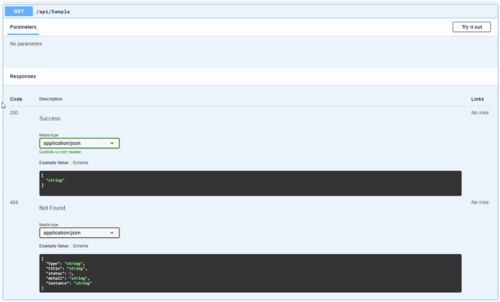4 回答
TA贡献1827条经验 获得超8个赞
虽然正确答案已经提交,但我想提供一个例子。假设您已将 Swashbuckle.AspNetCore 包添加到您的项目中,并在 Startup.Configure(...) 中使用它,如下所示:
app.UseSwagger();
app.UseSwaggerUI(options =>
{
options.SwaggerEndpoint("/swagger/v1/swagger.json", "My Web Service API V1");
options.RoutePrefix = "api/docs";
});
有一个像这样的测试控制器操作端点:
[HttpGet]
public ActionResult GetAllItems()
{
if ((new Random()).Next() % 2 == 0)
{
return Ok(new string[] { "value1", "value2" });
}
else
{
return Problem(detail: "No Items Found, Don't Try Again!");
}
}
将产生如下所示的 swagger UI 卡/部分(运行项目并导航到 /api/docs/index.html):

如您所见,没有为端点提供“元数据”。
现在,将端点更新为:
[HttpGet]
[ProducesResponseType(typeof(IEnumerable<string>), 200)]
[ProducesResponseType(404)]
public ActionResult GetAllItems()
{
if ((new Random()).Next() % 2 == 0)
{
return Ok(new string[] { "value1", "value2" });
}
else
{
return Problem(detail: "No Items Found, Don't Try Again!");
}
}
这根本不会改变端点的行为,但现在 swagger 页面如下所示:

这好多了,因为现在客户端可以看到可能的响应状态代码是什么,以及对于每个响应状态,返回数据的类型/结构是什么。请注意,虽然我没有定义 404 的返回类型,但 ASP.NET Core(我使用的是 .NET 5)足够聪明,可以将返回类型设置为ProblemDetails。
如果这是您想要采取的路径,最好将Web API 分析器添加到您的项目中,以接收一些有用的警告。
ps 我还想使用options.DisplayOperationId(); 在 app.UseSwaggerUI(...) 配置中。通过这样做,swagger UI 将显示映射到每个端点的实际 .NET 方法的名称。例如,上面的端点是对 /api/sample 的 GET,但实际的 .NET 方法称为 GetAllItems()
TA贡献1810条经验 获得超4个赞
我认为它对于不成功(200)返回代码可以派上用场。假设如果其中一个失败状态代码返回描述问题的模型,您可以指定该情况下的状态代码生成与成功情况不同的内容。
TA贡献1877条经验 获得超1个赞
它用于为 API 探索/可视化工具(例如 Swagger ( https://swagger.io/ ))生成开放 API 元数据,以在文档中指示控制器可能返回的内容。
TA贡献2003条经验 获得超2个赞
3种不同的使用选择
在所有应用程序控制器中:
public void Configure(IApplicationBuilder app, IWebHostEnvironment env)
{
app.UseSwaggerResponseCheck();
//...
}
使用 ValidateStatusCodes 属性的每个控制器操作:
[ApiController]
[Route("[controller]")]
public class ExampleController : ControllerBase
{
[HttpGet]
[ValidateStatusCodes] // <-- Use this
[SwaggerOperation("LoginUser")]
[SwaggerResponse(statusCode: StatusCodes.Status200OK, type: null, description: "signed user email account")]
[SwaggerResponse(statusCode: StatusCodes.Status400BadRequest, type: null, description: "wrong email or password")]
[Route("/users/login")]
public virtual IActionResult LoginUser([FromQuery][Required()] string email, [FromQuery] string password)
{
if (email == "email@gmail.com")
return Ok("success");
else if (email == "")
return BadRequest("email required");
else
return NotFound("user not found"); // 500 - InternalServerError because not attributed with SwaggerResponse.
}
// ...
[HttpGet]
[ValidateStatusCodes] // <-- Use this
[ProducesResponseType(type: typeof(Account), StatusCodes.Status200OK)]
[ProducesResponseType(StatusCodes.Status400BadRequest)]
[Route("/users/login2")]
public virtual IActionResult LoginUser2([FromQuery][Required()] string email, [FromQuery] string password)
{
if (email == "email@gmail.com")
return Ok("success").Validate();
else if (email == "")
return BadRequest("email required").Validate();
else
return NotFound("user not found").Validate(); // Throws error in DEBUG or Development.
}
}
使用 IStatusCodeActionResult.Validate() 的每个结果:
[ApiController]
[Route("[controller]")]
public class ExampleController : ControllerBase
{
[HttpGet]
[SwaggerOperation("LoginUser")]
[SwaggerResponse(statusCode: StatusCodes.Status200OK, type: null, description: "signed user email account")]
[SwaggerResponse(statusCode: StatusCodes.Status400BadRequest, type: null, description: "wrong email or password")]
[Route("/users/login")]
public virtual IActionResult LoginUser([FromQuery][Required()] string email, [FromQuery] string password)
{
if (email == "email@gmail.com")
return Ok("success").Validate();
else if (email == "")
return BadRequest("email required").Validate();
else if (email == "secret")
return Unauthorized("hello");
// Passed, independent of SwaggerResponse attribute.
else
return NotFound("user not found").Validate();
// 500 - InternalServerError because not attributed with SwaggerResponse.
}
// ...
[HttpGet]
[ProducesResponseType(type: typeof(Account), StatusCodes.Status200OK)]
[ProducesResponseType(StatusCodes.Status400BadRequest)]
[Route("/users/login2")]
public virtual IActionResult LoginUser2([FromQuery][Required()] string email, [FromQuery] string password)
{
if (email == "email@gmail.com")
return Ok("success").Validate();
else if (email == "")
return BadRequest("email required").Validate();
else
return NotFound("user not found").Validate(); // Throws error in DEBUG or Development.
}
}
- 4 回答
- 0 关注
- 450 浏览
添加回答
举报
